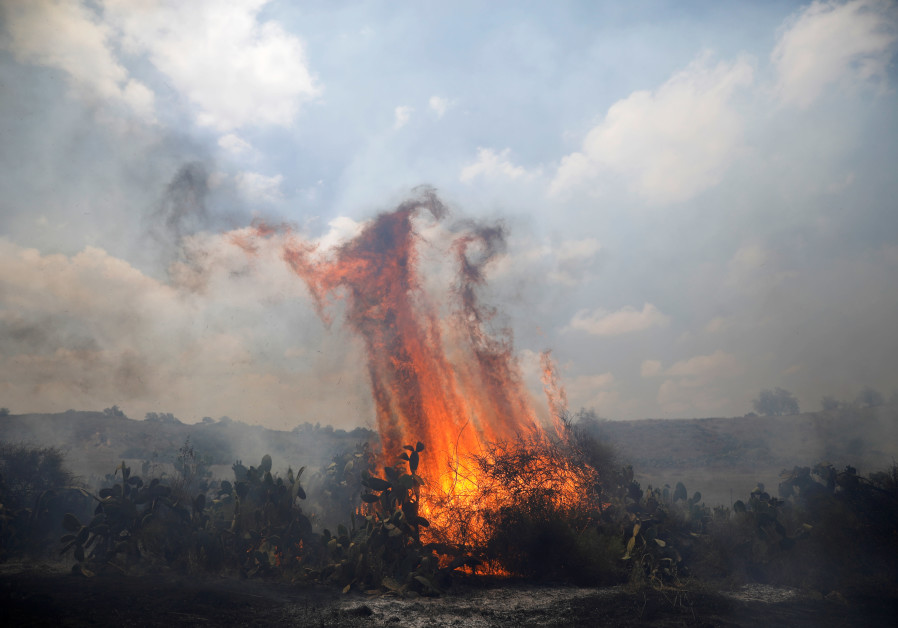From Gaza to Iraq: Fire is a new weapon of ISIS, Hamas and others

A fire burns in scrubland on the Israeli side of the border between Israel and the Gaza Strip, near kibbutz Gevaram. (photo credit: AMIR COHEN/REUTERS)
In 2018 Hamas hit upon a new way to terrorize Israel. Its activists and supporters began attaching incendiary devices to balloons and floating them over the border from Gaza. In Iraq Islamic State has also been burning fields across the center and north of the country to terrorize Iraqi farmers and to target various areas, including Sinjar where members of the Yazidi minority live.
More than 2,000 fires have been set in southern Israel and 8,700 acres burned between May 2018 and May 2019, according to the Meir Amit Intelligence and Information Center. The use of balloons to transport burning material over the border has increased according to the Meir Amit report. It is obviously an innovative strategy that Hamas set upon when it realized that its Great Return March mass protests and other activities, such as tunneling, had been thwarted.
The relationship between ISIS using burning fields to terrorize people and Hamas using balloons is not clear, but in the past extremist groups have barrowed tactics from Hamas to use across the region and the world. For instance suicide bombings, vehicular attacks, mass stabbings and other attacks became common methods to attack Israel before they became as common abroad.
Thousands of acres have been burned in Iraq and Syria in the last months as ISIS began using fire as a weapon. In May ISIS members infiltrated villages near Makhmur, an area that is exposed because it is along the line where Kurdish Peshmerga forces of the autonomous Kurdistan Regional Government patrol and where there is a gap between them and the Iraqi army forces. ISIS exploited this gap between Iraqi and Kurdish forces to begin threatening farmers. ISIS demanded taxes or it would burn their fields.
After those incidents ISIS began burning fields anyway, without any quid pro quo of taxes. It has struck across a swath of central and northern Iraq, usually near areas ISIS once controlled. This often either targets Kurdish areas or local Sunni Arab farmers or other groups, such as Shi’ites and Turkmen. Over the weekend on June 7 and 8 ISIS was accused of setting fires near Sinjar, an area where Yazidis live. In 2014 ISIS had attacked Sinjar and carried out a genocide against Yazidis. More than 3,000 are stillmissing. ISIS wants to show that even when it has been defeated militarily, as it was in Syria in March, its genocide will continue by keeping minorities from returning to their lands.
The overall amount of land torched in Iraq its thought to be more than 8,000 acres. A man who goes by the Twitter name Tom Cat and follows the Iraqi security forces closely wrote that the fires have destroyed around 1.6 percent of Iraq’s wheat and barley fields. Farmers are losing their livelihoods.
So far Iraq has not found a way to confront the fires. The country is still recovering from ISIS and the destruction its war caused from 2014 to 2018. Cities such as Mosul require major investment to rebuild. Yet ISIS is targeting the most vulnerable rural populations where security is still difficult to impose in places like Nineveh and between Kirkuk and Makhmur, or near Khanaquin. ISIS goal is to make it inhospitable for rural people to live normally and to keep people terrified. The locals who wondered if ISIS would return and who might have wavered in their support of the central government are being sent a message that ISIS is coming back. For minorities the message is also that their former villages are not safe to return to, that lurking in the night the arm of ISIS can still reach out.
Now is the time to join the news event of the year – The Jerusalem Post Annual Conference!
For more information and to sign up, click here>>







Comments are closed.